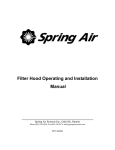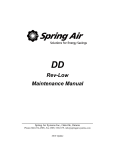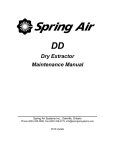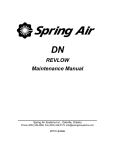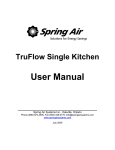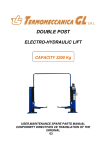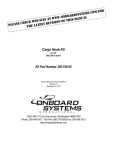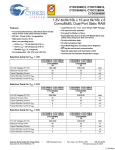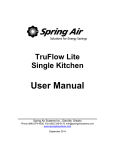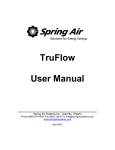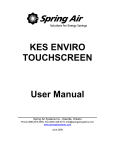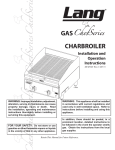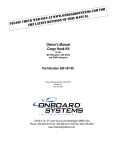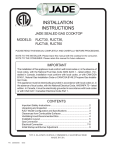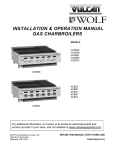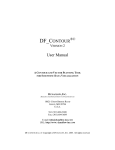Download KES Touchscreen User Manual 2009
Transcript
DN Dry Extractor Maintenance Manual ___________________________ Spring Air Systems Inc., Oakville, Ontario Phone (905) 338-2999, Fax (905) 338-0179, [email protected] 2010 Update DN Dry Extractor Maintenance and Operating Manual Table of Contents Introduction Spring Air Systems Hood Model Number Designations Principle of Operation Variflow Baffles Baffle Settings Extractor Insert Maintenance Schedule Cleaning the Exterior Trouble Shooting Installing the Terminator Baffle Measuring the Exhaust Airflow Measuring the Supply Airflow – MI Models Only Measuring the Supply Airflow – MB Models Only Measuring the Supply Airflow – MJ Models Only DN-Startup Report 1 2 2 3 4 4 5 5 5 6 7 8 9 11 12 DN Dry Extractor Maintenance and Operating Manual ULC/UL Listed Exhaust Hoods without Fire Dampers INTRODUCTION Thank you for selecting a SPRING AIR SYSTEMS INC. Commercial kitchen exhaust dry extractor. Your system consists of a dry extractor, exhaust fan and on/off switch. Others may have supplied the exhaust fan and on/off operator. Your SPRING AIR SYSTEMS INC. Dry extractor model was selected to best meet the design requirements of your commercial kitchen application. The DN series dry ventilator is a UL/ULC listed “Exhaust Hoods without Fire Dampers”. Typical SPRING AIR SYSTEMS Dry Ventilator Installation An ON/OFF selector switch located in the kitchen area or mounted on the exhaust fan starter coil electrical enclosure normally controls the exhaust fan. Dry Extractor Maintenance and Operating Manual 1 SPRING AIR SYSTEMS HOOD MODEL NUMBER DESIGNATIONS There are numerous types and styles of SPRING AIR SYSTEM dry ventilator available. Refer to the UL/ULC label for the complete model number and exhaust flow requirement for your dry ventilator. The UL/ULC label is located on the underside of the grease through on the right hand side of the dry ventilator. D D Dry Grease Extractor N No exhaust fire damper S B BS DB DI DF Shelf type hood Box type hood Box shelf type hood Double box type hood Single row Island hood Rev-low hood MG MP MI MC MR MB MJ F Make up air through front grilles Make up air through perforated panels Make up air internally Make up air down discharge through perforated Make up air through rear wall plenum DynaFlow Tri-Zone control system DynaFlow perimeter defense system Single row canopy finished on all sides, RevLow type 10 4 The length of the ventilator in feet The width of the ventilator in feet N B MP 10 4 Model Number Designation - Ventilators PRINCIPLE OF OPERATION The SPRING AIR SYSTEMS type “D” extractor is a high efficiency dry extractor. The type “D” extractor removes grease, dirt and lint through centrifugal force. Remove the front access door and wipe the interior with a damp cloth to manually wash the extractor chamber. The contaminated exhaust air enters the high velocity inlet slot A and flows through the transition zone to the VORTEX CHAMBER B. Centrifugal force causes the grease, dirt and lint particles to deposit on the PRIMARY VARIABLE FLOW BAFFLE G and VORTEX BAFFLE C. The sloping VORTEX BAFFLE C drains collected grease to the end of the ventilator into the grease cup H. The exhaust air continues into the secondary extraction chamber, which contains an aDNitional baffle, F. Residual grease is deposited on the secondary baffle as the exhaust air gyrates through the secondary chamber. Type “D” Extractor Dry Extractor Maintenance and Operating Manual 2 Variflow Baffles The most important component for the successful operation of a DN hood is the core extractor, which contains the Variflow baffles. The core extractor profile has been designed to facilitate the smooth flow of cooking vapors and dilution air from the roof of the hood, down along the front of the core extractor and into the core extractor slot. The Variflow baffles are located inside the core extractor along the entire length. The Variflow baffles are adjustable to provide between a 90 CFM/ft to 450 CFM/ft flow rate into the core extractor slot. The Variflow baffles are adjustable without any special tools by lifting off the core extractor removable insert and hand adjusting the position of the baffle. Just set the position of the Variflow baffle to match the appliance located below. See Figure below for isometric view of Variflow baffles. Section View of Core Extractor for DN-B Hood Roof of hood Exhaust duct collar Core extractor Variflow Baffle Front of hood Drain connection Baffle Closed Baffle Partially Closed Baffle Opened Section View of DN Extractor with Detail of Vari-flow Baffle Dry Extractor Maintenance and Operating Manual 3 BAFFLE SETTINGS Vari-flow Baffle labeling Each baffle is factory set base on the type of appliance under the hood. Extractor Insert Dry Extractor Maintenance and Operating Manual 4 MAINTENANCE SCHEDULE DAILY: 1.At the end of the cooking day wipe off the interior and exterior of the dry ventilator canopy and the underside of the grease trough with damp clothe. WEEKLY: 1.Remove the grease inserts and wash in a mild detergent and water mixture. 2.Cleaning the Hood Exterior Cleaning the Hood Exterior Wipe off the interior of the dry ventilator plenum behind the grease extractor inserts and the interior and exterior of the grease trough. Remove the grease cup and clean if necessary. SIX MONTHS 1.Check the exhaust fan belts for alignment, tighten, and wear. Adjust an/or replace. 2.Inspect the fusible link fire damper. Clean and/or replace the fusible link if necessary. 3.For hoods with makeup air only: remove the filter in makeup air plenum and wash in a mild detergent and water mixture. CLEANING THE EXTERIOR Normal soil can be removed with a mild detergent and water mixture applied to a cloth. To remove baked on grease, apply a cleanser to a damp cloth or sponge and rub on the metal in the direction of the polishing lines. DO NOT RUB IN A CIRCULAR MOTION. Burnt deposits, which do not respond, can usually be removed by rubbing the surface with a SCOTCHBRITE scouring pad of STAINLESS scouring pads. DO NOT USE ORDINARY STEEL WOOL. Heat tint can be removed by a vigorous scouring in the direction of the polish lines using a SCOTCH BRITE of STAINLESS scouring pad in conjunction with a powdered cleanser. TROUBLE SHOOTING Low air (i) (ii) (iii) (iv) (iv) Improper exhaust fan rotation. Broken or slipping belt. Exhaust ductwork inspection door open. Obstruction in the ductwork. Variflow baffle must be adjusted No Air (i) (ii) (iii) (iv) (v) (v) Broken belt. Exhaust fan overload tripped. Exhaust fan disconnect open. Exhaust fan motor fuse blown. Fire damper closed. Check if baffle are upside down in extractor. Dry Extractor Maintenance and Operating Manual 5 INSTALLING THE TERMINATOR BAFFLE The TBDD Terminator baffle is available in various lengths to suit adverse site conditions. This will provide additional exhaust air over heavy appliances that are being effected by the surrounding environment. Installation: Remove the TBDD from the packing material. Take off all of the Removable Access Doors “A” from the hood. You should be able to clearly see all the adjustable baffles “B” and their settings. Ensure that the adjustable baffle(s) “B” over the heavy appliance is set at 5, or 3 if the baffle is directly beneath the exhaust duct collar. The TBDD baffles “C” are going to be installed on the adjustable baffles “B” over the light appliances. To install the TBDD baffle “C” onto the adjustable baffle “B” simply line up the gap on the TBDD baffle “C” with the lower end of baffle “B”. Tap the TBBD along the length until it is snug on baffle “B”. If the fit is loose remove the TBBD baffle “C” and gently tap the gap with a hammer in the middle and at each end. Re-attach to baffle “B”. Install these baffles on the two adjustable baffles “B” located on the right or left side of the charbroiler (when looking from the front of the hood). Dry Extractor Maintenance and Operating Manual 6 MEASURING THE EXHAUST AIRFLOW The exhaust air is measured along the inlet slot of the ventilator. To ensure accurate results take a reading every foot along the length of the ventilator is recommended. VANAXIAL VELOMETER PITOT TUBE OR ANEMOMETER Hold the instrument perpendicular to the VORTEX BAFFLE and parallel to the throat (inlet slot) of the ventilator. Take three readings across the throat and average the results. Hold the instrument perpendicular to the VORTEX BAFFLE and parallel to the throat (inlet slot) of the ventilator. Velometer should not exceed three inches in diameter. Measuring Exhaust Air Measuring Exhaust Air Calculating the Exhaust Air Calculate the average velocity across the inlet slot and refer to the chart below for the corresponding CFM/ft (l/s/m). Ventilator Type Velocity B, S, and front & back slot of DB B, S, and front & back slot of DB B, S, and front & back slot of DB B, S, and front & back slot of DB B, S, and front & back slot of DB B, S, and front & back slot of DB B, S, and front & back slot of DB B, S, and front & back slot of DB B, S, and front & back slot of DB B, S, and front & back slot of DB Exhaust Air Volume Fpm m/s CFM/ft l/s/m 450 675 900 1125 1350 1575 1800 2000 2250 2450 2.3 3.4 4.6 5.7 6.9 8.0 9.2 10.2 11.5 12.5 100 150 200 250 300 350 400 450 500 550 140 210 275 340 410 480 550 620 690 755 Dry Extractor Maintenance and Operating Manual 7 MEASURING THE SUPPLY AIRFLOW - MI MODELS ONLY The supply air discharge from a DN-B-MI or DN-DB-MI is measured along the internal discharge perforated plate inside the filter hood canopy. To ensure accurate results take a reading every foot along the length of the filter hood. VANAXIAL VELOMETER Hold the instrument parallel to and about one (1) inch from the perforated discharge slot. Measuring Supply Air Figure 8 PITOT TUBE OR ANEMOMETER Hold the instrument parallel to and about one (1) inch from the perforated discharge slot. Take two readings across the slot and average the results. Measuring Supply Air Calculate the average velocity along the length of the perforated discharge and refer to chart No. 2 for corresponding CFM/ft (l/s/m). If the supply air is too high adjust the opposed blade dampers on top of the filter hood at the supply air inlets just above the supply fire dampers. Multiple dampers can be balanced to provide the velocity profile required across the supply discharge. Supply Velocity vs. Supply Flow Rate Supply Discharge Velocity fpm m/s 400 2.1 600 3.1 800 4.1 1000 5.1 Supply Flow Rate CFM/ft 120 180 240 300 Dry Extractor Maintenance and Operating Manual l/s/m 186 372 372 466 8 MEASURING THE SUPPLY AIRFLOW - MB Measuring the total supply fan airflow through the Blade: _____1. Remove Blade front discharge perforated panel with appropriate tools. _____2. Turn Blade’s threaded rod counter-clockwise until the Blade comes to a fully open position, which is required to determine the total supply volume at each hood. _____3. Turn supply fan on. _____4. Re-install Blade front discharge perforated plate with appropriate tools. _____5. Take velocity reading across the perforated plate as shown in the diagram below. Take two vertical readings, one at 2” from the bottom of perforation and one at 4”. Repeat these horizontal readings every 12” along the hood. _____6. Total all readings and divide by the number of reading to determine the average velocity. _____7. Multiply the average velocity x 72 x length of perforated panel (in inches) to determine the total CFM per perforated panel. (It is critical to take the velocity readings 1” off the surface of the perforated panel to use this formula). _____8. If the total supply volume was not correct and Spring Air Systems provided the supply fan/unit then adjust the supply volume at the fan/unit or at field supplied balancing dampers. If the supply fan/unit was not provided by Spring Air Systems advise the general contractor to adjust the supply air volume and do not proceed unit the volume has been correct. The total supply volume required can be found on the Spring Air Systems shop drawings. Dry Extractor Maintenance and Operating Manual 9 Measuring supply airflow through the Custom Comfort Dial: _____1. Remove Blade front discharge perforated panel with appropriate tools. _____2. Turn Blade’s threaded rod clockwise until the blade is 1.5 inches off the vertical front surface of the hood. See diagram below. _____3. Set the velometer parallel to the bottom discharge with the face open perpendicular to the perforated screen where the air discharges and take a reading every 12” apart for the full length of the hood. See diagram below. _____4. Total all velocity readings and divide by the number of reading to determine the average velocity. _____5. Refer to Custom Comfort Dial Velocity Chart below. Based on the hood length and the temperature rating indicated on the UL/ULC plate determine the Custom Comfort Dial Velocity. _____6. If the measured average velocity is too high, turn the Blade threaded rod counter-clockwise 5 times. Re-measure average velocity. Repeat until the measured velocity at Comfort Comfort Dial is correct. _____7. If the measured average velocity is too low, turn the Blade threaded rod clockwise 5 times. Remeasure average velocity. Repeat until the measured velocity of Comfort Comfort Dial is correct. FN or FB Hood Custom Comfort Dial Velocity Chart APPLIANCES CCD VELOCITY (fpm) 0 9 - 14 6-9 4-6 Up to 4 Set point 500 500 550 550 SIDE FLOW Set point 450 450 450 450 0 9 - 14 6-9 4-6 Up to 4 450 450 450 450 400 400 450 450 TEMP. Heavy - Charbroiler Heavy - Charbroiler Heavy - Charbroiler Heavy - Charbroiler 600 F 0 600 F 0 600 F 0 600 F Medium Medium Medium Medium 400 F 0 400 F 0 400 F 0 400 F – Griddle, fryer – Griddle, fryer – Griddle, fryer – Griddle, fryer Hood Length (ft) FRONT Dry Extractor Maintenance and Operating Manual 10 MEASURING THE SUPPLY AIRFLOW - MJ The supply air is measured along the bottom inside discharge opening of the make up air plenum. To ensure accurate results take a reading every one foot along the length of the ventilator. Measure supply air flow through comfort dial: _____1. Ensure the MJ blowers are powered when the exhaust fan is activated. _____2. Locate the rheostat on the back of the MJ Blower which is on top of the MJ plenum. _____3. Turn the rheostat 120 degree clock-wise to activate the MJ blower. _____4. Set the velometer parallel to the bottom discharge with the face open perpendicular to the perforated screen where the air discharges and take a reading every 12” apart for the full length of the hood. The first reading should be one inch from the end and continue every twelve inches to the opposite end of the ventilator. _____5. Total all velocity readings and divide by the number of readings to determine the average velocity. _____6. Refer to Comfort Comfort Dial Velocity Chart below. Based on the hood length and the hood temperature rating indicated on the UL/ULC plate determine the Comfort Comfort Dial velocity on the chart. _____7. If the measured average velocity is not correct adjust the rheostat as follows: Rotate clockwise for lower or counterclockwise for higher velocity. Retake the velocity reading to confirm the recommended set point. FN or FB Hood Custom Comfort Dial Velocity Chart APPLIANCES CCD VELOCITY (fpm) 0 9 - 14 6-9 4-6 Up to 4 Set point 500 500 550 550 SIDE FLOW Set point 450 450 450 450 0 9 - 14 6-9 4-6 Up to 4 450 450 450 450 400 400 450 450 TEMP. Heavy - Charbroiler Heavy - Charbroiler Heavy - Charbroiler Heavy - Charbroiler 600 F 0 600 F 0 600 F 0 600 F Medium Medium Medium Medium 400 F 0 400 F 0 400 F 0 400 F – Griddle, fryer – Griddle, fryer – Griddle, fryer – Griddle, fryer Hood Length (ft) FRONT Dry Extractor Maintenance and Operating Manual 11 DN- STARTUP REPORT General Information Job Name Date Customer Location Spring Air Service Exhaust Fan Model No. Manufacturer Up blast Discharge Exhaust Fan HP Exhaust Air Design (CFM) Supply Air Design (CFM) Ventilator mounting Height from finished floor to front of hood Make Up Air Systems yes Good no Fair Poor None Hood Item Model Width Baffle Size * Baffle No. Baffle Setting Left to Right 1 2 3 4 5 6 Total Exhaust Measured CFM Design Exhaust CFM Length No. of Baffles Design CFM Velocity Reading (fpm) Calculated Exhaust Volume per Baffle (CFM) ** Length No. of Baffles Design CFM Velocity Reading (fpm) Calculated Exhaust Volume per Baffle (CFM) ** Hood Item Model Width Baffle Size * Baffle No. Baffle Setting Left to Right 1 2 3 4 5 6 Total Exhaust Measured CFM Design Exhaust CFM Dry Extractor Maintenance and Operating Manual 12 Hood Item Model Width Baffle Size * Baffle No. Baffle Setting Left to Right 1 2 3 4 5 6 Total Exhaust Measured CFM Design Exhaust CFM Length No. of Baffles Design CFM Velocity Reading (fpm) Calculated Exhaust Volume per Baffle (CFM) ** Length No. of Baffles Design CFM Velocity Reading (fpm) Calculated Exhaust Volume per Baffle (CFM) ** Length No. of Baffles Design CFM Velocity Reading (fpm) Calculated Exhaust Volume per Baffle (CFM) ** Hood Item Model Width Baffle Size * Baffle No. Baffle Setting Left to Right 1 2 3 4 5 6 Total Exhaust Measured CFM Design Exhaust CFM Hood Item Model Width Baffle Size * Baffle No. Baffle Setting Left to Right 1 2 3 4 5 6 Total Exhaust Measured CFM Design Exhaust CFM Dry Extractor Maintenance and Operating Manual 13 Other Fine Products From • RevLow Hoods • DynaFlow Hoods • TruFlow Energy Management Systems • UL/ULC Listed Pollution Control Systems • Dry Extractor Hoods • Catridge Hoods • Filter Hoods • Water Wash Ventilators • Surface Fire Suppression • Commercial Kitchen Exhaust Fans • Commercial Kitchen Supply Units • Utility Distribution Systems Phone: 866-874-4505, FAX: 905-338-0179 [email protected] www.springairsystems.com
















